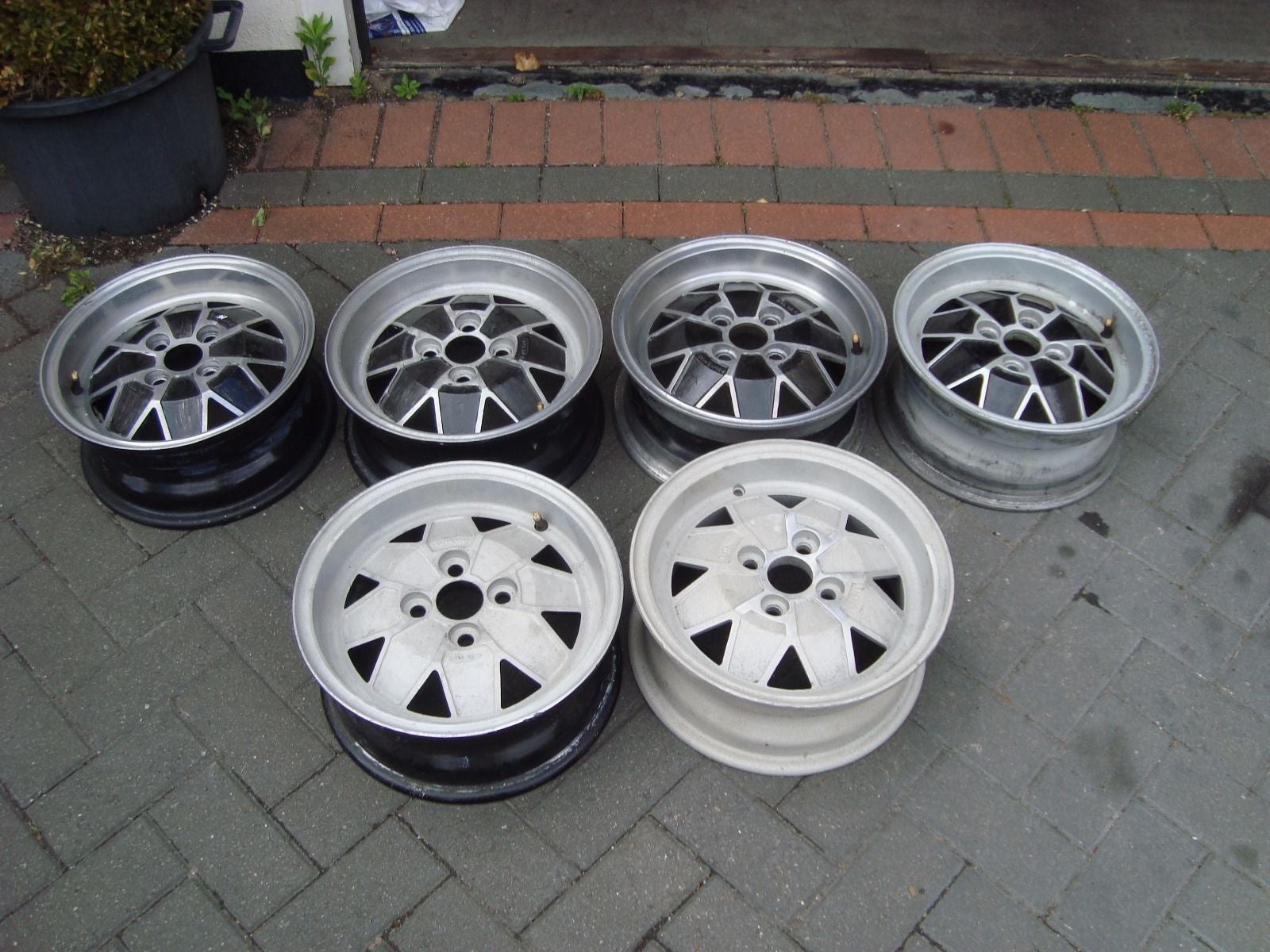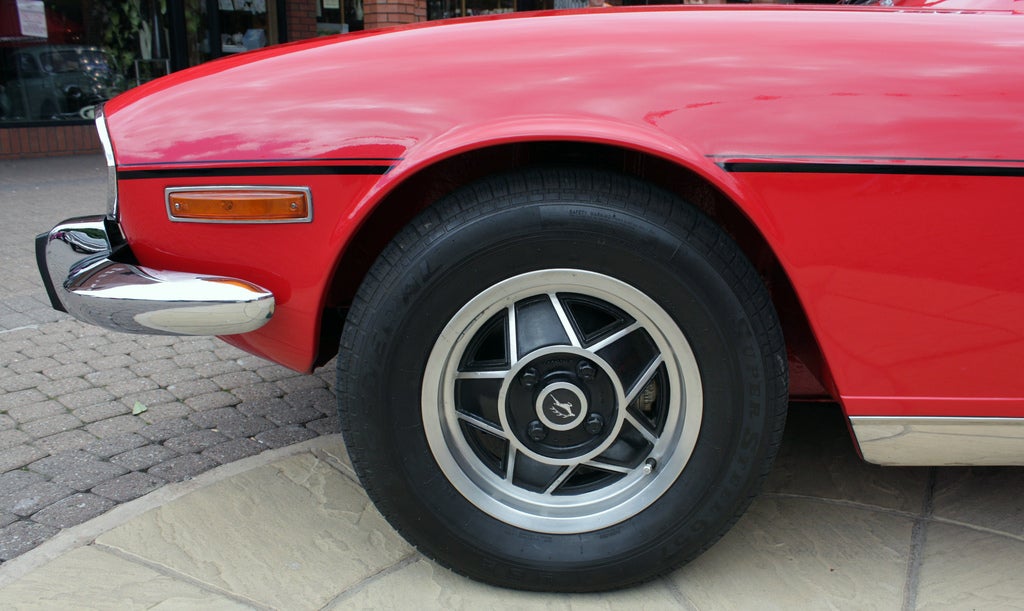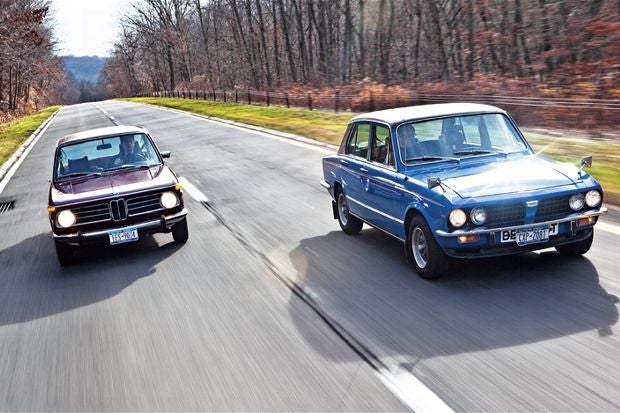 "BiTurbo228 - Dr Frankenstein of Spitfires" (biturbo228)
"BiTurbo228 - Dr Frankenstein of Spitfires" (biturbo228)
07/10/2015 at 06:32 ē Filed to: Spit6
 4
4
 31
31
 "BiTurbo228 - Dr Frankenstein of Spitfires" (biturbo228)
"BiTurbo228 - Dr Frankenstein of Spitfires" (biturbo228)
07/10/2015 at 06:32 ē Filed to: Spit6 |  4 4
|  31 31 |

...which are Dolomite Sprint alloys (and most importantly £100 cheaper than the Cosmic Mk2s I bought previously, so I can sell them to bankroll my quaife LSD). Same specs as the Cosmics, but the offsetís different so Iíll have to run spacers. Question is this. I hear everywhere that running spacers increases wear on the wheel bearings, but I donít think thatís the whole picture.
From what I understand, the increased wear is caused by greater leverage applied from having the wheel pushed out further away from the hub. But if Iím just making it so that the offset is the same as stock, it shouldnít have that effect.
If Iím right, that would mean that any wheels, spacers or not, that push the centreline of the wheels further out from the hub increase wheel bearing wear.
So the question is, am I right?
 Steve in Manhattan
> BiTurbo228 - Dr Frankenstein of Spitfires
Steve in Manhattan
> BiTurbo228 - Dr Frankenstein of Spitfires
07/10/2015 at 06:42 |
|
I donít know - all I know is that any variation from stock used to make me veeery nervous. Iím guessing increased tire wear at minimum, but you need an expert.
Wonder if those might be off Hammondís car. It was pretty well shot when he was done with it.
 4muddyfeet - bare knuckle with an EZ30
> BiTurbo228 - Dr Frankenstein of Spitfires
4muddyfeet - bare knuckle with an EZ30
> BiTurbo228 - Dr Frankenstein of Spitfires
07/10/2015 at 06:47 |
|
I would agree with that, although I imagine it will be absolutely minimal leverage/wear increase if the wheels are the same offset as stock. Are the Dolly wheel's weight rating the same as the stock Spits?
 That Bastard Kurtis - An Attempt to Standardize My Username Across Platforms
> BiTurbo228 - Dr Frankenstein of Spitfires
That Bastard Kurtis - An Attempt to Standardize My Username Across Platforms
> BiTurbo228 - Dr Frankenstein of Spitfires
07/10/2015 at 06:48 |
|
Well, just sitting here visualizing it, what youíre saying makes sense. Iíve seen it said that adding spacers is like going to the wrong offset, which is exactly what it is, but if youíre adding spacers to stay at the stock offset, I canít see where youíd have a problem.
 BiTurbo228 - Dr Frankenstein of Spitfires
> That Bastard Kurtis - An Attempt to Standardize My Username Across Platforms
BiTurbo228 - Dr Frankenstein of Spitfires
> That Bastard Kurtis - An Attempt to Standardize My Username Across Platforms
07/10/2015 at 06:53 |
|
Thatís what I was thinking...
 BiTurbo228 - Dr Frankenstein of Spitfires
> 4muddyfeet - bare knuckle with an EZ30
BiTurbo228 - Dr Frankenstein of Spitfires
> 4muddyfeet - bare knuckle with an EZ30
07/10/2015 at 06:54 |
|
Pass on the weight rating, never come across it before :S if itís the ĎJí in Ď5.5Jí that Iíve never known what it meant, then yeah theyíre the same :)
 BiTurbo228 - Dr Frankenstein of Spitfires
> Steve in Manhattan
BiTurbo228 - Dr Frankenstein of Spitfires
> Steve in Manhattan
07/10/2015 at 06:55 |
|
I doubt theyíre the ones off Hammondís car. Thereís a lot of these wheels floating around so the chances of it being those particular ones are pretty slim...
 Steve in Manhattan
> BiTurbo228 - Dr Frankenstein of Spitfires
Steve in Manhattan
> BiTurbo228 - Dr Frankenstein of Spitfires
07/10/2015 at 07:00 |
|
Did they use a version of those (or similar) wheels on the Triumph Staaaag?
 BiTurbo228 - Dr Frankenstein of Spitfires
> Steve in Manhattan
BiTurbo228 - Dr Frankenstein of Spitfires
> Steve in Manhattan
07/10/2015 at 07:06 |
|
Yeah they used similar ones on the Stag. 5-spoke though, 14Ē and different PCD:

 Steve in Manhattan
> BiTurbo228 - Dr Frankenstein of Spitfires
Steve in Manhattan
> BiTurbo228 - Dr Frankenstein of Spitfires
07/10/2015 at 07:16 |
|
Watched the Stag Car SOS (again) recently - damn, I love that show.
 4muddyfeet - bare knuckle with an EZ30
> BiTurbo228 - Dr Frankenstein of Spitfires
4muddyfeet - bare knuckle with an EZ30
> BiTurbo228 - Dr Frankenstein of Spitfires
07/10/2015 at 07:24 |
|
J is the shape of the rim, but you can probably ignore my above comments, I think it may only be neccesary for commercial vehicles and light trucks. The entire basis of my car knowledge is due to Land Rovers :/
 505 - morphine not found
> BiTurbo228 - Dr Frankenstein of Spitfires
505 - morphine not found
> BiTurbo228 - Dr Frankenstein of Spitfires
07/10/2015 at 07:33 |
|
No idea, but as physics is all about where you would draw your arrows, i suppose youíre correct :-)
Nice wheels though. What size are these?
 BiTurbo228 - Dr Frankenstein of Spitfires
> 505 - morphine not found
BiTurbo228 - Dr Frankenstein of Spitfires
> 505 - morphine not found
07/10/2015 at 07:41 |
|
Yeah I like them better than my Cosmics :) theyíre 5.5J x 13. Dinky little things, but fit rather well for a dinky car like a spit. Just got a batch of paint to refurb them as well. Theyíre in better nick overall than the cosmics, but are a bit mismatched...
 BiTurbo228 - Dr Frankenstein of Spitfires
> Steve in Manhattan
BiTurbo228 - Dr Frankenstein of Spitfires
> Steve in Manhattan
07/10/2015 at 07:42 |
|
Yeah itís a fantastic premise. Definitely the noblest of all the Ďlets fix a car upí shows :)
 505 - morphine not found
> BiTurbo228 - Dr Frankenstein of Spitfires
505 - morphine not found
> BiTurbo228 - Dr Frankenstein of Spitfires
07/10/2015 at 07:45 |
|
I just drove something yesterday on 10Ē magnesium wheels. You might be able to guess what...
 Funktheduck
> 505 - morphine not found
Funktheduck
> 505 - morphine not found
07/10/2015 at 07:57 |
|
Was it your gfís grandmother?
 505 - morphine not found
> Funktheduck
505 - morphine not found
> Funktheduck
07/10/2015 at 08:15 |
|
Watch your language, punk, youíre only allowed to speak in the highest regard about a lady of that caliber

 MasterMario - Keeper of the V8s
> BiTurbo228 - Dr Frankenstein of Spitfires
MasterMario - Keeper of the V8s
> BiTurbo228 - Dr Frankenstein of Spitfires
07/10/2015 at 08:28 |
|
The leverage is not created by where the contact patch of the tire is but where the face of the rim meets the face of the hub/rotor. By putting a spacer in you will absolutely increase the lever arm. It will have greater stresses on it and wear out quick, how much that affects it though is anyone's geuss
 CalzoneGolem
> BiTurbo228 - Dr Frankenstein of Spitfires
CalzoneGolem
> BiTurbo228 - Dr Frankenstein of Spitfires
07/10/2015 at 08:46 |
|
I have an affection for Dolomite Sprints. I fell in love with them because of top gear. Love these wheels.
 BiTurbo228 - Dr Frankenstein of Spitfires
> 505 - morphine not found
BiTurbo228 - Dr Frankenstein of Spitfires
> 505 - morphine not found
07/10/2015 at 09:00 |
|
Hmmm, Iíd guess an OG Mini seeing as I donít think they sold Hillman Imps across the pond...
Oh, and that Wallace and Grommit pic below is absolute gold :)
 RamblinRover Luxury-Yacht
> BiTurbo228 - Dr Frankenstein of Spitfires
RamblinRover Luxury-Yacht
> BiTurbo228 - Dr Frankenstein of Spitfires
07/10/2015 at 09:19 |
|
Basic ordinary loading wonít get worse on your wheel bearings, as that partís mostly still just in shear if the point of force vs. the point of support donít alter (i.e. if the final offset is the same). Side loading changes would depend on things like wheel flex somewhat - there are parts of the setup that would experience greater leverage (like your wheel studs), but I donít think the bearings would be among them in most cases. In summary, shouldnít have much of an impact.
 BiTurbo228 - Dr Frankenstein of Spitfires
> CalzoneGolem
BiTurbo228 - Dr Frankenstein of Spitfires
> CalzoneGolem
07/10/2015 at 09:27 |
|
Theyíre kickass little cars, again hamstrung a bit by the whole BL debacle (and Saab incidentally, who are to blame for the angled head studs as they wanted an engine whose head could be removed while keeping the cam in place).
Every bit a competitor for the 2002 though, and the 16v Sprint was quicker than the Tii by an appreciable margin. Even moreso if you rebuilt the engine with care (they make 135bhp rather than 127bhp if you jsut rebuild them properly).
 CalzoneGolem
> BiTurbo228 - Dr Frankenstein of Spitfires
CalzoneGolem
> BiTurbo228 - Dr Frankenstein of Spitfires
07/10/2015 at 09:28 |
|
Also, real wood trim!
 BiTurbo228 - Dr Frankenstein of Spitfires
> MasterMario - Keeper of the V8s
BiTurbo228 - Dr Frankenstein of Spitfires
> MasterMario - Keeper of the V8s
07/10/2015 at 09:29 |
|
Interesting. Iím just trying to work that through in my head. So I would increase the lever arm even if the spacer essentially moved the offset of my new wheels back to the same as the stock wheels?
 Funktheduck
> 505 - morphine not found
Funktheduck
> 505 - morphine not found
07/10/2015 at 09:42 |
|
Youíre the one who brags about being elbow deep.
;)
 MasterMario - Keeper of the V8s
> BiTurbo228 - Dr Frankenstein of Spitfires
MasterMario - Keeper of the V8s
> BiTurbo228 - Dr Frankenstein of Spitfires
07/10/2015 at 09:53 |
|
Itís all about where the wheel is connected to the axle. Thatís where the force is being transmitted. So if you move that force out youíll increase the lever arm even if the tire is in the same exact position.
 Trevor Slattery, ACTOR
> BiTurbo228 - Dr Frankenstein of Spitfires
Trevor Slattery, ACTOR
> BiTurbo228 - Dr Frankenstein of Spitfires
07/10/2015 at 09:58 |
|

http://www.automobilemag.com/reviews/drivenÖ
 Trevor Slattery, ACTOR
> BiTurbo228 - Dr Frankenstein of Spitfires
Trevor Slattery, ACTOR
> BiTurbo228 - Dr Frankenstein of Spitfires
07/10/2015 at 10:08 |
|
I always remind people that the limiting factor in all of this will be the tires. If you are running regular tires under ďnormalĒ driving conditions, there should be no problem save for maybe slightly accelerated tire wear.
Now you start running high performance tires and start subjecting the car to severe sideloads via high g cornering...you can run into issues. I know that the axles, especially on the front of the larger Triumphs, were prone to flexing under hard driving. Upgraded kits are available for them. While I have not heard of the same issue with the little Triumphs, I would make a point of inspecting axles (and lower trunnions, keep those fronts lubed!) for wear if running upgraded wheel/tire combos. Especially so if racing/hooning is a regular occurrence.
 BiTurbo228 - Dr Frankenstein of Spitfires
> CalzoneGolem
BiTurbo228 - Dr Frankenstein of Spitfires
> CalzoneGolem
07/10/2015 at 10:10 |
|
That was one of their draws when they were new. They were basically miniature Triumph 2000s, with all the luxuries you found in those bigger cars.
Actually, that was Triumphís market niche. They were in the same price bracket as upscale Fords and Vauxhalls, but rather than being tarted up versions of cheap cars, they were dedicated luxury vehicles with the fit and finish to match.
Pretty much what BMW is today actually. Thatís probably why BMW kept the Triumph name when they sold the Rover Group. Thereís a lot of positive sentiment for Triumph here, and it could have upset BMW in the Ď00s if someone made a competitor here in the UK...
 BiTurbo228 - Dr Frankenstein of Spitfires
> RamblinRover Luxury-Yacht
BiTurbo228 - Dr Frankenstein of Spitfires
> RamblinRover Luxury-Yacht
07/10/2015 at 10:15 |
|
Yeah I thought the only increased strain would be on the studs. Normally, offset is designed so that the vehicleís weight rests equally (or proportionally) between the inner and outer bearing races. So long as that remains the same itís fine wear-wise.
Iím moving to M12 studs from the weedy stock ones anyway, so that should be sorted :)
 BiTurbo228 - Dr Frankenstein of Spitfires
> Trevor Slattery, ACTOR
BiTurbo228 - Dr Frankenstein of Spitfires
> Trevor Slattery, ACTOR
07/10/2015 at 10:58 |
|
Yeah the front wheel bearings are a bit of a weak spot on the small-chassis Triumphs. Only really shows itself as you start tuning them, but thereís an upgrade kit with beefier bearings that Iíll be getting :)
Thereís also a very fancy trunnionless vertical links that puts a ball joint at the bottom rather than a trunnion, which Iím also thinking of investing in :)
 BiTurbo228 - Dr Frankenstein of Spitfires
> Trevor Slattery, ACTOR
BiTurbo228 - Dr Frankenstein of Spitfires
> Trevor Slattery, ACTOR
07/10/2015 at 11:54 |
|
Great read :) the press at the time were of a similar opinion (although I have been reading mainly British articles, so a bit of favouritism is inevitable). Iím fairly confident that if, rather than mashing together the small but successful Leyland with the huge and failing BMC to make BL, theyíd waited until BMC went bankrupt and Leyland cherry-picked the profitable bits out of BMC the British car manufacturing landscape would be utterly different to today. The will was there to make great cars, just not the means.
Think of this as a line-up:
Jaguar:
-XJ6
-XJ12
-E-Type
Rover:
-P6 3500
-P6 2200
-P6BS (look up the prototype, itís cool as fuck)
-P8
Triumph:
-TR6
-2000/2500
-GT6
-Spitfire
-Dolomite/Toledo
MG:
-MGB
-MGB V8 (ditch the C, go straight for the V8)
-Midget
-ADO16
Austin/Morris:
-ADO16
-Mini
-Austin-Healey 3000
-Austin-Healey Sprite
-Marina (much though itís hated, this proposed super-company needs bread-and-butter cars and it sold well)
Land Rover:
-Series
-Range Rover
Itís like an all-star cast of great British cars. Cut out the chaff of endlessly feuding BMC nameplates and dozens of factories of pissed off workers (they can be floated off post-bankruptcy to the government if they want to have a stab at running a car company).
With a much more profitable lineup as a percentage, they can pay their workers a bit better which would improve build quality. They can actually put the time and effort required into testing and troubleshooting new models that would mean their mechanicals are much more sound. And then they can work on rationalisation of components to increase economies of scale between divisions (something BL was actually rather good at, even if it was something that was forced upon them by circumstance).
Sure theyíve got a number of competing model lines, but they can use that to generate publicity from rivalry. Whichever side wins, BL still gets the sales, and it helps breed hardcore fans that would choose Triumph/MG/Rover/Jaguar over any competitor, internal or external.